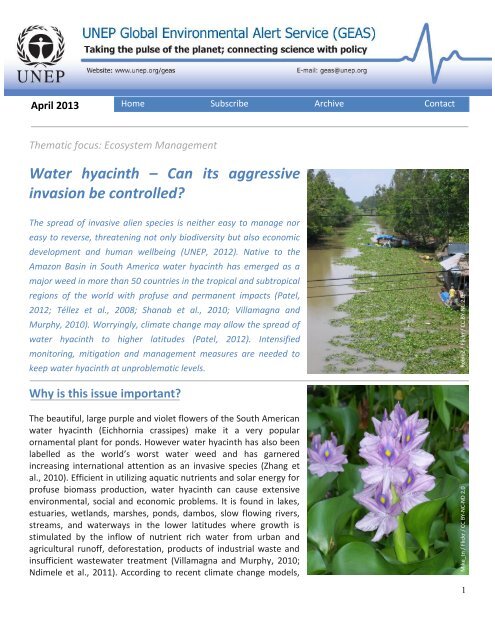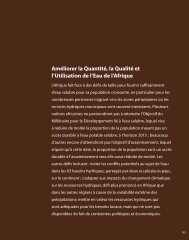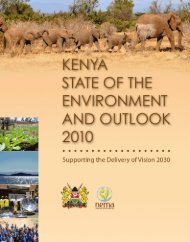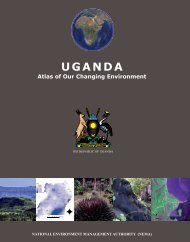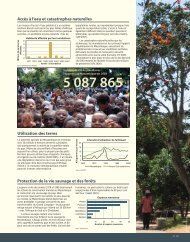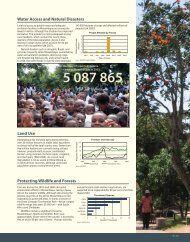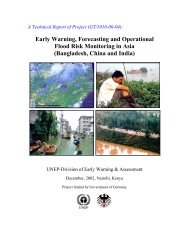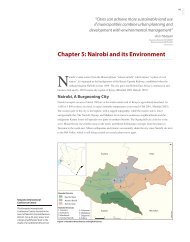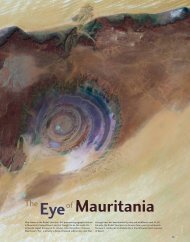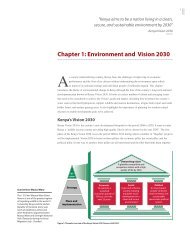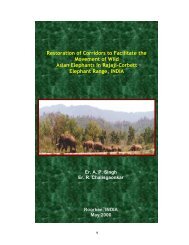Water hyacinth - UNEP/GRID-Sioux Falls
Water hyacinth - UNEP/GRID-Sioux Falls
Water hyacinth - UNEP/GRID-Sioux Falls
Create successful ePaper yourself
Turn your PDF publications into a flip-book with our unique Google optimized e-Paper software.
April 2013<br />
Home Subscribe Archive Contact<br />
Thematic focus: Ecosystem Management<br />
<strong>Water</strong> <strong>hyacinth</strong> – Can its aggressive<br />
invasion be controlled?<br />
The spread of invasive alien species is neither easy to manage nor<br />
easy to reverse, threatening not only biodiversity but also economic<br />
development and human wellbeing (<strong>UNEP</strong>, 2012). Native to the<br />
Amazon Basin in South America water <strong>hyacinth</strong> has emerged as a<br />
major weed in more than 50 countries in the tropical and subtropical<br />
regions of the world with profuse and permanent impacts (Patel,<br />
2012; Téllez et al., 2008; Shanab et al., 2010; Villamagna and<br />
Murphy, 2010). Worryingly, climate change may allow the spread of<br />
water <strong>hyacinth</strong> to higher latitudes (Patel, 2012). Intensified<br />
monitoring, mitigation and management measures are needed to<br />
keep water <strong>hyacinth</strong> at unproblematic levels.<br />
Why is this issue important?<br />
The beautiful, large purple and violet flowers of the South American<br />
water <strong>hyacinth</strong> (Eichhornia crassipes) make it a very popular<br />
ornamental plant for ponds. However water <strong>hyacinth</strong> has also been<br />
labelled as the world’s worst water weed and has garnered<br />
increasing international attention as an invasive species (Zhang et<br />
al., 2010). Efficient in utilizing aquatic nutrients and solar energy for<br />
profuse biomass production, water <strong>hyacinth</strong> can cause extensive<br />
environmental, social and economic problems. It is found in lakes,<br />
estuaries, wetlands, marshes, ponds, dambos, slow flowing rivers,<br />
streams, and waterways in the lower latitudes where growth is<br />
stimulated by the inflow of nutrient rich water from urban and<br />
agricultural runoff, deforestation, products of industrial waste and<br />
insufficient wastewater treatment (Villamagna and Murphy, 2010;<br />
Ndimele et al., 2011). According to recent climate change models,<br />
RobinZ / Flickr / CC BY-NC 2.0<br />
Mike_tn / Flickr / CC BY-NC-ND 2.0<br />
1
its distribution may expand into higher latitudes as temperatures rise, posing problems to formerly <strong>hyacinth</strong><br />
free areas (Rahel and Olden, 2008).<br />
What are the findings?<br />
Invasive alien species are a major global challenge requiring urgent action (Xu et al. 2012). They are<br />
considered one of the key pressures on the world’s biodiversity: altering ecosystem services and processes,<br />
reducing native species abundance and richness, and decreasing genetic diversity of ecosystems (Rands et al.,<br />
2010; Vila et al., 2011; Hejda et al., 2009). They cause substantial economic losses estimated by one study to<br />
total US$120 billion annually in the USA (Pimentel et al. 2005; Kettunen et al., 2009). In South Africa,<br />
estimated economic costs due to invasive alien species are currently above US$ 700 million (R6.5 billion) per<br />
annum or 0.3% of South Africa’s GDP, and could rise to over 5% of GDP if invasive plants are allowed to reach<br />
their full potential (Wilgen and Lange, 2011).<br />
<strong>Water</strong> <strong>hyacinth</strong> has been identified by the International Union for Conservation of Nature (IUCN) as one of the<br />
100 most aggressive invasive species (Téllez et al., 2008) and recognized as one of the top 10 worst weeds in<br />
the world (Shanab et al., 2010; Gichuki et al., 2012; Patel, 2012). It is characterised by rapid growth rates,<br />
extensive dispersal capabilities, large and rapid reproductive output and broad environmental tolerance<br />
(Zhang et al., 2010). In Africa, for example, where water <strong>hyacinth</strong> is listed by law as a noxious weed in several<br />
countries, it is the most widespread and damaging aquatic plant species. The economic impacts of the weed in<br />
seven African countries have been estimated at between US$20-50 million every year. Across Africa costs may<br />
be as much as US$100 million annually (<strong>UNEP</strong>, 2006).<br />
The success of this invasive alien species is largely due to its reproductive output. <strong>Water</strong> <strong>hyacinth</strong> can flower<br />
throughout the year and releases more than 3 000 seeds per year (Gopal, 1987; EEA, 2012). The seeds are<br />
long-lived, up to 20 years (Gopal, 1987). While seeds may not be viable at all sites, water <strong>hyacinth</strong> commonly<br />
colonises new areas through vegetative reproduction and propagation of horizontally growing stolons. In the<br />
early stages of infestation, the weed takes foothold on the shoreline in the areas where native aquatic plants<br />
thrive (Gichuki et al., 2012). However, it is not restricted to shallow water, unlike many submersed and<br />
emergent macrophytes, because its roots are free-floating near the surface (Villamagna and Murphy, 2010).<br />
Global Environment Facility (GEF) / Flickr / CC BY-NC-SA 2.0<br />
2
Geographical distribution and pathways of introduction<br />
<strong>Water</strong> <strong>hyacinth</strong> is found across the tropical and subtropical regions (Figure 1). Originally from the Amazon<br />
Basin, its entry into Africa, Asia, Australia, and North America was facilitated by human activities (Dagno et al.,<br />
2012).<br />
Figure 1. Global distribution of water <strong>hyacinth</strong> (Map redrawn by <strong>UNEP</strong>/DEWA from Téllez et al. 2008).<br />
Africa has particularly been affected by the introduction and<br />
spread of water <strong>hyacinth</strong>, facilitated in part due to a lack of<br />
naturally occurring enemies. In a review of water <strong>hyacinth</strong><br />
infestation in eastern, southern and central Africa, Mujingni<br />
(2012) reports that the weed was first recorded in Zimbabwe in<br />
1937. It colonized important water bodies, such as the Incomati<br />
River in Mozambique in 1946, the Zambezi River and some<br />
important rivers in Ethiopia in 1956. Rivers in Rwanda and<br />
Burundi were colonised in the late 1950s while the rivers Sigi<br />
and Pangani in Tanzania were infested in 1955 and 1959. The<br />
plant colonised Kafue river in Zambia in the 1960s, the Shire<br />
River in Malawi in 1968 and Lake Naivasha in Kenya in 1986<br />
(Mironga et al., 2012). The plant was recorded from Lakes Kyoga<br />
in Uganda in 1988-89, Victoria in 1989–1990, Malawi/Nyasa in<br />
1996 and Tanganyika in 1997. Lake Victoria in Africa is the<br />
second largest freshwater lake in the world and currently<br />
supports approximately 30 million people. Infestation of water<br />
<strong>hyacinth</strong> in the lake has been a serious nuisance, generating<br />
public outcry (World Agro Forestry Centre, 2006; Kateregga and<br />
Sterner, 2007; Gichuki et al., 2012). At its peak, it was estimated<br />
Invasive water <strong>hyacinth</strong> in Zambezi<br />
Richard Droker / Flickr / CC BY-NC-ND 2.0<br />
3
that the weed was growing at 3 hectares (12 acres) per day on the lake (Ayodo and Jagero, 2012). The plant<br />
also spread fast throughout Uganda’s lakes and rivers in just 10 years.<br />
<strong>Water</strong> <strong>hyacinth</strong> has also spread to West Africa. It was first reported in Cameroon between 1997 and 2000 and<br />
since then the country’s wetlands have become “home” for the weed (Forpah, 2009). In Nigeria almost all<br />
river bodies have been dominated by water <strong>hyacinth</strong> (Borokini and Babalola, 2012). The water <strong>hyacinth</strong><br />
problem is especially severe on the river Niger in Mali where human activities and livelihoods are closely<br />
linked to the water systems (Dagno et al., 2012). It occurs throughout the Nile Delta in Egypt and is believed to<br />
be spreading southwards, due to the construction of the Aswan Dam which has slowed down the river flow,<br />
enabling the weed to invade (Dagno et al., 2007). Infestation of water <strong>hyacinth</strong> in Ethiopia has also been<br />
manifested on a large scale in many water bodies of the Gambella area, Lake Ellen in the Rift Valley and Lake<br />
Tana (Fessehaie, 2012).<br />
In Europe, water <strong>hyacinth</strong> is established locally in the Azores (France) and in Corsica (Italy), and casual records<br />
are known from Belgium, the Czech Republic, Hungary, the Netherlands and Romania (EEA, 2012) In<br />
particular, it is a threat in Spain and Portugal (DellaGreca et al., 2009).<br />
In Asia, water <strong>hyacinth</strong> is widespread on freshwater wetlands of the Mekong Delta, especially in standing<br />
water (MWBP/RSCP, 2006). It has been detected in the Sundarbans mangrove forest of Bangladesh (Biswas et<br />
al., 2007) and has caused heavy siltation in the wetlands of the Kaziranga National Park, India. Deepor Beel, a<br />
freshwater lake formed by the Brahmaputra River is heavily infested with this weed (Patel, 2012). The lake is<br />
considered one of the large and important riverine wetlands in the Brahmaputra valley of lower Assam, India.<br />
As in many other countries, water <strong>hyacinth</strong> has caused many economic, social and environmental problems in<br />
southern China (Choo et al., 2006).<br />
In Mexico, more than 40,000 hectares of reservoirs, lakes, canals and drains are infested with water <strong>hyacinth</strong><br />
(Jime0nez and Balandra, 2007). In California, USA, this weed has caused severe ecological impacts in the<br />
Sacramento- San Joaquin River Delta (Khanna et al., 2011).<br />
<strong>Water</strong> <strong>hyacinth</strong> covering a waterway in south of India<br />
aruner./ Flickr/ .CC BY-NC-SA 2.0<br />
4
Threats posed by water <strong>hyacinth</strong><br />
i. Destruction of biodiversity<br />
Today, biological alien invasions are a major driver of biodiversity loss worldwide, (Pyšek and Richardson,<br />
2010; Vila et al., 2011). <strong>Water</strong> <strong>hyacinth</strong> is challenging the ecological stability of freshwater water bodies<br />
(Khanna et al., 2011; Gichuki et al., 2012), out-competing all other species growing in the vicinity, posing a<br />
threat to aquatic biodiversity (Patel, 2012). Besides suppressing the growth of native plants and negatively<br />
affecting microbes, water <strong>hyacinth</strong> prevents the growth and abundance of phytoplankton under large mats,<br />
ultimately affecting fisheries (Gichuki et al., 2012; Villamagna and Murphy, 2010).<br />
ii. Oxygen depletion and reduced water quality<br />
Large water <strong>hyacinth</strong> mats prevent the transfer of oxygen from the air to the water surface, or decrease<br />
oxygen production by other plants and algae (Villamagna and Murphy, 2010). When the plant dies and sinks to<br />
the bottom the decomposing biomass depletes oxygen content in the water body (EEA, 2012). Dissolved<br />
oxygen levels can reach dangerously low concentrations for fish that are sensitive to such changes.<br />
Furthermore, low dissolved oxygen conditions catalyse the release of phosphorus from the sediment which in<br />
turn accelerates eutrophication and can lead to a subsequent increase in water <strong>hyacinth</strong> or algal blooms<br />
(Bicudo et al., 2007). Death and decay of water <strong>hyacinth</strong> vegetation in large masses deteriorates water quality<br />
and the quantity of potable water, and increases treatment costs for drinking water (Patel, 2012; Mironga et<br />
al. 2011; Ndimele et al., 2011).<br />
iii. Breeding ground for pests and vectors<br />
Floating mats of water <strong>hyacinth</strong> support organisms that are detrimental to human health. The ability of its<br />
mass of fibrous, free-floating roots and semi-submerged leaves and stems to decrease water currents<br />
increases breeding habitat for the malaria causing anopheles mosquito as evidenced in Lake Victoria<br />
(Minakawa et al., 2008). Mansonioides mosquitoes, the vectors of human lymphatic filariasis causing<br />
nematode Brugia, breed on this weed (Chandra et al., 2006; Varshney et al., 2008). Snails serving as vector for<br />
the parasite of Schistosomiasis (Bilharzia) reside in the tangled weed mat (Borokini and Babalola, 2012).<br />
<strong>Water</strong> <strong>hyacinth</strong> has also been implicated in harbouring the causative agent for cholera. For example, from<br />
1994 to 2008, Nyanza Province in Kenya, which borders Lake Victoria accounted for a larger proportion of<br />
cholera cases than expected given its population size (38.7% of cholera cases versus 15.3% of national<br />
population). Yearly water <strong>hyacinth</strong> coverage on the Kenyan section of the lake was positively associated with<br />
the number of cholera cases reported in the Province (Feikin et al., 2010). At the local level increased<br />
incidences of crocodile attacks have been attributed to the heavy infestation of the weed which provides<br />
cover to the reptiles and poisonous snakes (Patel, 2012; Ndimele et al., 2011).<br />
iv. Blockage of waterways hampering agriculture, fisheries, recreation and hydropower<br />
<strong>Water</strong> <strong>hyacinth</strong> often clogs waterways due to its rapid reproduction and propagation rate. The dense mats<br />
disrupt socioeconomic and subsistence activities (ship and boat navigation, restricted access to water for<br />
recreation, fisheries, and tourism) if waterways are blocked or water pipes clogged (Ndimele et al., 2011;<br />
Patel, 2012). The floating mats may limit access to breeding, nursery and feeding grounds for some<br />
economically important fish species (Villamagna and Murphy, 2010). In Lake Victoria, fish catch rates on the<br />
Kenyan section decreased by 45% because water <strong>hyacinth</strong> mats blocked access to fishing grounds, delayed<br />
access to markets and increased costs (effort and materials) of fishing (Kateregga and Sterner, 2009). In the<br />
Wouri River Basin in Cameroon the livelihood of close to 900,000 inhabitants has been distorted; the entire<br />
Abo and Moundja Moussadi creeks have been rendered impassable by the weed leading to a<br />
complete halt in all the<br />
5
socioeconomic activities with<br />
consequent rural exodus (Mujingni,<br />
2012). The weed has made navigation<br />
and fishing an almost impossible task in<br />
Nigeria (Ndimele et al., 2011).<br />
While navigation in the Brahmaputra<br />
River in India has been affected by the<br />
weed, it has also blocked irrigation<br />
channels and obstructed the flow of<br />
water to crop fields (Patel, 2012). For<br />
example, in West Bengal, it causes an<br />
annual loss of paddy (Patel, 2012) by<br />
directly suppressing the crop, inhibiting<br />
rice germination and interfering with<br />
harvesting (EEA, 2012). The dense<br />
growth entangles with boat propellers,<br />
hampering fishing (Patel, 2012). <strong>Water</strong><br />
<strong>hyacinth</strong> slows water flow by 40 to 95%<br />
in irrigation channels (Jones, 2009),<br />
which may cause severe flooding. The<br />
communities of Bwene and Bonjo in the<br />
Wouri River Basin in Cameroon regularly<br />
suffer from floods during the rainy<br />
season due to blockage of waterways<br />
around the villages by the weed<br />
(Mujingni, 2012).<br />
It is estimated that the flow of water in<br />
the Nile could be reduced by up to one<br />
tenth due to increased losses from<br />
evapotranspiration by water <strong>hyacinth</strong> in<br />
Lake Victoria (Ndimele et al., 2011).<br />
<strong>Water</strong> loss by the same process and<br />
blocking of turbines on Kafue Gorge in<br />
Zambia translates into lost water for<br />
power generation and eventually into<br />
lost revenue of about US$15 million<br />
every year for the power company (ZEO,<br />
2008). Many large hydropower schemes<br />
are also suffering the effects of water<br />
<strong>hyacinth</strong> (Shanab et al., 2010). For<br />
example, cleaning intake screens at the<br />
Owen <strong>Falls</strong> hydroelectric power plant at<br />
Jinja in Uganda were calculated to be<br />
US$1 million per annum (Mailu, 2001).<br />
arsheffield / flickr / CC BY-NC 2.0<br />
6
May 1989: Hyacinth in Lake Chivero<br />
May 2000: weed almost controlled<br />
Control measures<br />
<strong>Water</strong> <strong>hyacinth</strong> control is absolutely essential<br />
(Villamagna and Murphy, 2010). Control methods that<br />
are often used include mechanical, chemical and<br />
biological control. However, existing methods have<br />
often been insufficient to contain the aggressive<br />
propagation of the weed and viability of its seeds<br />
despite substantial monetary investments over the<br />
years (Gichuki et al., 2012), mainly due to lack of<br />
continued policy and management support by<br />
governments. The weed infestation on Lake Chivero<br />
which supplies water to Harare, Zimbabwe, was<br />
controlled and declined from 42% in 1976 to 22% in<br />
2000. Re-invasion began to emerge in 2005 and<br />
included massive amounts of another invasive plant,<br />
spaghetti weed (Hydrocotyle ranunculoide (<strong>UNEP</strong>,<br />
2008). The October 2012 image shows the extent of<br />
re-invasion (Figure 2).<br />
May 2005: Weed begins to re-invade Landsat<br />
Oct 2012: weed has colonised the shoreline<br />
Figure 2: Satellite images showing progressive invasion, control and re-invasion of water <strong>hyacinth</strong> on Lake<br />
Chivero, Zimbabwe (Image source: Google Earth and Landsat).<br />
7
i. Manual and mechanical control<br />
Physical methods for control of water <strong>hyacinth</strong> involve drainage of the water body, manual removal of the<br />
weeds or pulling through nets (Patel, 2012). Employing machines like weed harvesters, crusher boats, and<br />
destruction boats prove expensive, approximately US$600-1,200 per hectare (Malik, 2007; Villamagna and<br />
Murphy, 2010) as well as unpractical for areas larger than a hectare given the rapid rate of increase of the<br />
weed. There may also be additional fees for disposal of plant material. The costs of water <strong>hyacinth</strong><br />
management in China were estimated to amount around EUR 1 billion annually (EEA, 2012). In Europe,<br />
management costs to remove 200,000 tonnes of the plant along 75 km in the Guadiana river basin on the<br />
Portuguese-Spanish border amounted to EUR 14,680,000 between 2005 and 2008 (EEA, 2012). Dagno et al.<br />
(2007) reported that mechanical management of the weed in Mali cost around US$ 80,000–100,000 per year.<br />
Maintaining a clear passage for ships to dock at Port Bell in Uganda is estimated to cost US$ 3-5 million per<br />
year (Mailu, 2001). Yet, while mechanical removal has been effective to a considerable extent, the infestations<br />
soon return because shredded bunches of the weed are carried by waves to other unaffected areas where<br />
they establish and start proliferating (Shanab et al., 2010).<br />
Manual removal of water <strong>hyacinth</strong>, Kisumu, Kenya Global Environment Facility (GEF) / Flickr / CC BY-NC-SA 2.0<br />
ii. Chemical control<br />
A generally cheaper method has been used worldwide to reduce water <strong>hyacinth</strong> populations through the use<br />
of chemical herbicides (such as Paraquat, Diquat, Glyphosate, Amitrole, 2, 4-D acid) (Villamagna and Murphy,<br />
2010). However, their use directly interferes with the biocontrol agents currently deployed against this weed.<br />
Long term use may degrade water quality and put aquatic life at risk (Malik, 2007) with significant socioeconomic<br />
impacts if beneficial or designated uses of the water body such as drinking and preparing food are<br />
affected (Dagno et al., 2012). Considering that hundreds of thousands of hectares have been invaded by the<br />
weed, it is unlikely that it will be controlled by chemical means alone (Borokini and Babalola, 2012).<br />
8
iii. Biological control<br />
In recent years, focus has shifted to natural<br />
enemies of water <strong>hyacinth</strong> including plant<br />
pathogens (Dagno et al., 2012; Villamagna<br />
and Murphy, 2010). The aim of any<br />
biological control is not to eradicate the<br />
weed, but to reduce its abundance to a level<br />
where it is no longer problematic. While<br />
there exists several native enemies of water<br />
<strong>hyacinth</strong>, two South American weevil beetles<br />
(Neochetina eichhorniae and Neochetina<br />
bruchi) and two water <strong>hyacinth</strong> moth species<br />
(Niphograpta albiguttalis and Xubida<br />
infusella) have had effective long-term<br />
control of water <strong>hyacinth</strong> in many countries,<br />
notably at Lake Chivero (Zimbabwe), Lake<br />
Victoria (Kenya), Louisiana (USA), Mexico,<br />
Papua New Guinea and Benin (Williams et<br />
al., 2007; Venter et al., 2012; Gichuki et al.,<br />
2012; Dagno et al., 2012). Researchers have<br />
identified another tiny insect, Megamelus<br />
scutellaris, from South America which is<br />
highly host-specific to water <strong>hyacinth</strong> and<br />
does not pose a threat to native or<br />
economically important species (Coetzee et<br />
al., 2009).<br />
The weevils reduce water <strong>hyacinth</strong> vigour by<br />
decreasing plant size, vegetative<br />
reproduction, and flower and seed<br />
production. They also facilitate the transfer<br />
and ingress of deleterious microorganisms<br />
associated with the weevils (both fungi and<br />
bacteria) into the plant tissues (Venter et al.,<br />
2012).<br />
Control of water <strong>hyacinth</strong> using fungal<br />
pathogens has greatly stimulated interest in<br />
the management of the weed. Several fungal<br />
species among theme Cercospora rodmanii,<br />
Alternaria alternata and A. eichhorniae are<br />
recognized as potential mycoherbicide<br />
agents although no commercial<br />
mycoherbicide is available for water<br />
<strong>hyacinth</strong> (Dagno et al., 2012).<br />
<strong>Water</strong> <strong>hyacinth</strong> weevils<br />
<strong>Water</strong> <strong>hyacinth</strong> plants stressed by weevils tend to be of small stature and lose<br />
buoyancy<br />
G. Goergen, IITA Image Library / Flickr / CC BY-NC 2.0<br />
IITA Image Library / Flickr / CC BY-NC 2.0<br />
9
Box 1. An example of the benefits of biological control<br />
Between 1991 and 1993, a biological control program of<br />
water <strong>hyacinth</strong> was undertaken in Southern Benin. It<br />
consisted of the release of three natural enemies, two<br />
weevil species (these are the two Neochetina spp.) and<br />
one moth that feed exclusively on water <strong>hyacinth</strong>. In 1999,<br />
a survey of 365 men and women from 192 households in<br />
24 villages in the target area revealed that water <strong>hyacinth</strong>,<br />
although not eliminated, was perceived by the villagers as<br />
having been reduced from a serious pest to one of minor<br />
or moderate importance. At the peak of the infestation<br />
water <strong>hyacinth</strong> had reduced the yearly income of this<br />
population of about 200 000 by approximately US$84<br />
million. Lost revenues for men were mostly in fishing,<br />
while women experienced lost revenues in trade, primarily<br />
food crops and fish. The reduction of water <strong>hyacinth</strong> cover<br />
through biological control was credited with an increase in<br />
income of US$30.5 million per year. The total cost of the<br />
control program is estimated at a present value of US$2.09<br />
million. The benefits therefore appear to outweigh the<br />
costs by a ratio of 124:1 (De Groote et al. 2003).<br />
Ganvié, Benin<br />
iv. Reduction by utilisation<br />
Research into the utilisation and related technologies for the control of water <strong>hyacinth</strong> have been tested over<br />
the last few decades (Ndimele et al., 2011). It is being speculated that the biomass can be used in waste water<br />
treatment, heavy metal and dye remediation, as substrate for bioethanol and biogas production, electricity<br />
generation, industrial uses, medicines, animal feed, agriculture and sustainable development (Patel, 2012).<br />
However, seldom does utilisation provide a sustained solution to the spread and impact of water <strong>hyacinth</strong>,<br />
and in fact could provide a perverse incentive to maintain the invasive plant to the detriment of the<br />
environment and production systems at high economic and social costs. There is not one example from<br />
anywhere in the world where utilisation alone has contributed to the management of any invasive plant (EEA,<br />
2012).<br />
Waste water treatment and clean-up of polluted environment<br />
<strong>Water</strong> <strong>hyacinth</strong> has the potential to clean up various contaminated waters (Mahamadi and Nharingo, 2010;<br />
Rahman and Hasegawa, 2011; Smolyakov, 2012). It can be used to treat wastewater from dairies, tanneries,<br />
sugar factories, pulp and paper industries, palm oil mills, distilleries etc. (Jafari, 2010). The plant can absorb<br />
into its tissues large quantities of heavy metals from the water column and grows very well in water polluted<br />
with organic contaminants and high concentrations of plant nutrients (Chunkao et al., 2012; Ndimele, 2012).<br />
In the Ologe Lagoon, Nigeria, water <strong>hyacinth</strong> that was not deliberately introduced into the lagoon to absorb<br />
heavy metals did so, even when the concentration of the heavy metals in the water column was very small<br />
Carsten ten Brink / Flickr / CC BY-NC-ND 2.0<br />
10
(Ndimele and Jimoh, 2011). In California, water <strong>hyacinth</strong> leaf tissue was found to have the same mercury<br />
concentration as the sediment beneath, suggesting that plant harvesting could help mediate mercury<br />
contamination (Greenfield et al., 2007). While water <strong>hyacinth</strong>’s capacity to absorb nutrients makes it a<br />
potential biological alternative for treatment of agro-industrial wastewater, one of the major challenges is<br />
how to properly dispose the vast amount of the plant materials which may have to be considered as toxic<br />
waste (Zhang, 2012).<br />
As alternative fuel and energy source<br />
<strong>Water</strong> <strong>hyacinth</strong> fulfills all the criteria deemed necessary for bioenergy production – it is perennial, abundantly<br />
available, non-crop plant, biodegradable and has high cellulose content; however its strong disadvantage is<br />
that it has over 90% water content which complicates harvesting and processing. The biomass can be<br />
subjected to biogas production to generate energy for household uses in rural areas (Chuang et al., 2011).<br />
Experiments in China show that mixing biomass of water <strong>hyacinth</strong> with pig manure leads to a much higher<br />
biogas production than by using pig manure alone (Lu et al., 2010). It can also be used for producing ethanol,<br />
but technical and logistical challenges need to be overcome before the commercial scale ethanol production<br />
becomes a reality because of the high tissue water content (Ndimele et al., 2011).<br />
Semi-industrial uses and household articles<br />
As a readily available resource, water <strong>hyacinth</strong> has been used in several small cottage industries in the<br />
Philippines, Indonesia and India for paper, rope, basket, mats, shoes, sandals, bags, wallets, vases, etc<br />
(Ndimele et al., 2011; Patel, 2012). Yet these are rarely successful to reduce infestations and the market for<br />
these products is far too small to have any impact on water <strong>hyacinth</strong> populations. In addition, income<br />
generation may facilitate its spread to new, uninvaded, water bodies.<br />
Animal feedstock and agricultural use<br />
When sun-dried, water <strong>hyacinth</strong> has been found to be rich in protein, vitamins and minerals and serves as a<br />
high quality feedstock for some non-ruminant animals, poultry and fishery in Indonesia, China, the Philippines<br />
and Thailand (Lu et al., 2010; Saha and Ray, 2011). But it is not recommended for use if primarily used for<br />
removal of heavy metals and toxic substances from wastewater (Chunkao et al., 2012). Decomposed water<br />
<strong>hyacinth</strong> can also be used as green manure or as compost that improves poor quality soils (Ndimele et al.,<br />
2011). However, its high alkalinity (pH>9) and potentially toxic heavy metals contents would restrict its use to<br />
flowering-plants, with no allowable application to horticulture for edible vegetables (Chunkao et al., 2012;<br />
Zhang 2012).<br />
What are the implications for policy?<br />
<strong>Water</strong> <strong>hyacinth</strong> infestation is a symptom of broader watershed management and pollution problems. It calls<br />
for a concise national and transboundary water <strong>hyacinth</strong> policy designating the plant as noxious weed to<br />
aquatic systems. In October 2010, world leaders adopted the Strategic Plan for Biodiversity (2011–2020)<br />
targeting the need for identification of invasive alien species and pathways, the need to control and eradicate<br />
priority species, and to manage pathways in order to prevent further invasions (CBD, 2010).<br />
Given the complexity of control options and the potential for climate change to assist the spread of water<br />
<strong>hyacinth</strong>, it is critical to develop comprehensive management strategies and action plans. A multidisciplinary<br />
approach should be designed, which ensures that the highest political and administrative levels recognize the<br />
11
potential seriousness of the weed. Plans should also state clearly the role of each government department,<br />
stakeholders, municipal councils and local community involved in the fight against water <strong>hyacinth</strong>.<br />
Awareness needs to be raised amongst local communities and all stakeholders on the inherent dangers of<br />
water <strong>hyacinth</strong> infestation to mobilize riparian communities towards control measures. One practical<br />
approach is to involve communities in manual and biological control activities, for example, in rearing weevils.<br />
There are excellent examples of community involvement in the rearing and distribution of the weevils to<br />
control the <strong>hyacinth</strong> around Lake Victoria.<br />
Methods for water <strong>hyacinth</strong> control should include reduction of nutrient load in the water bodies through<br />
treatment of waters flowing from sewage works, urban wastes and factories. Changing land use practices in<br />
the riparian communities through watershed management will help reduce agricultural runoff as a mechanism<br />
for controlling the proliferation of water <strong>hyacinth</strong>. This is considered by many as one of the most sustainable<br />
long-term management actions.<br />
In order for policy makers to make informed decisions, much more economic information is required on the<br />
costs and benefits of environmental programs. For example, it is frequently stated that there are insufficient<br />
resources to control <strong>hyacinth</strong>. However, if the costs of improved water treatment are compared with the costs<br />
of decreased fish catches and the costs of increased water-borne diseases, it is likely that resources needed<br />
for <strong>hyacinth</strong> control are modest in comparison to potential losses from its proliferation (see Box 1).<br />
While researchers continue to investigate the perceived potential uses of water <strong>hyacinth</strong>, the current negative<br />
impacts of the weed far outweigh its benefits. The use of water <strong>hyacinth</strong> as raw material in cottage industry<br />
should not encourage propagation of the weed, but rather help control its growth.<br />
Acknowledgement<br />
Writer: Mwangi Theuri a<br />
Production and Outreach Team: Arshia Chander b , Erick Litswa a , Kim Giese b , Lindsey Harriman b , Michelle Anthony b ,<br />
Reza Hussain b , Mwangi Theuri a and Zinta Zommers a<br />
Special thanks to Zinta Zommers a , Anna Stabrawa a , Frank Turyatunga a , Neeyati Patel a , Max Zieren c , Maxwell<br />
Gomera d and Arne Witt e for their valuable inputs and review.<br />
( a <strong>UNEP</strong>/DEWA/Nairobi, b <strong>UNEP</strong>/<strong>GRID</strong>-<strong>Sioux</strong> <strong>Falls</strong>, c <strong>UNEP</strong>-ROAP, d <strong>UNEP</strong>-WCMC, e CAB International-Nairobi)<br />
References<br />
Ayodo, T. and Jagero, N., 2012. The economic, educational and social responsibilities of elders development<br />
groups in lake Victoria region. Academic Research International, 2 (3):610-620.<br />
Bicudo, D., Fonseca, B., Bini, L., Crossetti, L., Bicudo, C. and Araujo-Jesus, T., 2007. Undesirable side-effects of<br />
water <strong>hyacinth</strong> control in a shallow tropical reservoir. Freshwater Biology, 52, 1120–1133.<br />
Biswas, S., Choudhury, J., Nishat, A., Rahman, M., 2007. Do invasive plants threaten the Sundarbans mangrove<br />
forest of Bangladesh? Forest Ecol Manag 245:1–9.<br />
12
Borokoni, T. and Babalola, F., 2012. Management of invasive plant species in Nigeria through economic<br />
exploitation: lessons from other countries. Management of Biological Invasions 3 (1): 45–55 doi:<br />
http://dx.doi.org/10.3391/mbi.2012.3.1.05.<br />
CBD, 2010. Strategic Plan for Biodiversity 2011–2020. Secretariat of the Convention on Biological Diversity,<br />
Montreal. http://www.cbd.int/decision/cop/?id=12268 (accessed 23 April 2013).<br />
Chandra, G., Ghosh, A., Biswas, D. and Chatterjee, S., 2006. Host plant preference of Mansonia mosquitoes. J<br />
Aquatic Plant Manage 44:142–144.<br />
Choo, T., Lee, C., Low, K. and Hishamuddin, O., 2006. Accumulation of chromium (VI) from aqueous solutions<br />
using water lilies (Nymphaea spontanea). Chemosphere 62:961–996.<br />
Chuang, Y-S., Lay, C-H., Sen, B., Che,n C-C., Gopalakrishnan,. K., Wu, J-H., Lin, C-S. and Lin, C-Y., 2011.<br />
Biohydrogen and biomethane from water <strong>hyacinth</strong> (Eichhornia crassipes) fermentation: effects of substrate<br />
concentration and incubation temperature. Int J Hydr Energy 36:14195–14203.<br />
Chunkao, K., Nimpee, C, and Duangmal, 2012. The King's initiatives using water <strong>hyacinth</strong> to remove heavy<br />
metals and plant nutrients from wastewater through Bueng Makkasan in Bangkok, Thailand. Ecological<br />
Engineering 39: 40–52.<br />
Coetzee, J., Hill, M., Julien, M., Center, T. and Cordo, H., 2009. Eichhornia crassipes (Mart.) Solms–Laub.<br />
(Pontederiaceae). In: Biological Control of Tropical Weeds using Arthropods, (ed). R. Muniappan, G. V. P.<br />
Reddy, and A. Raman. Cambridge University Press, Cambridge. 183-210.<br />
Dagno, K., Lahlali, R., Diourte, M., and Haissam, J., 2012. Fungi occurring on water<strong>hyacinth</strong> (Eichhornia<br />
crassipes [Martius] Solms-Laubach) in Niger River in Mali and their evaluation as Mycoherbicides. J. Aquat.<br />
Plant Manage. 50: 25-32.<br />
Dagno, K., Lahlali, R., Friel, D., Bajji, M. and Jijakli, H., 2007. Review: problems of the water <strong>hyacinth</strong>,<br />
Eichhornia crassipes in the tropical and subtropical areas of the world, in particular its eradication using<br />
biological control method by means of plant pathogens. Biotechnol. Agron. Soc. Environ. 11 (4): 299-311.<br />
De Groote, H., Ajuonua, O, Attignona, S, Djessoub, R, and Neuenschwandera, P (2003). Economic impact of<br />
biological control of water <strong>hyacinth</strong> in Southern Benin. Ecological Economics, 45 (1): 105 – 117.<br />
DellaGreca, M., Previtera, L. and Zarrelli, A., 2009. Structures of new phenylphenalene-related compounds<br />
from Eichhornia crassipes (water <strong>hyacinth</strong>). Tetrahedron 65:8206–8208.<br />
EEA, 2012. The impacts of invasive alien species in Europe. EEA Technical report No 16/2012. Luxembourg:<br />
Publications Office of the European Union, 2012. http://www.eea.europa.eu/publications/impacts-of-invasivealien-species<br />
(accessed 12 March 2013).<br />
Feikin, D., Tabu, C. and Gichuki, J., 2010. Does water <strong>hyacinth</strong> on East African lakes promote cholera<br />
outbreaks? American Journal of Tropical Medicine and Hygiene 83: 370–373. doi:10.4269/ajtmh.2010.09-<br />
0645.<br />
13
Fessehaie, R., 2012. Status of water <strong>hyacinth</strong> (Eichhornia crassipes) in Ethiopia: Challenges and response. In:<br />
Berihun Tefera, Workiye Worie and Melaku Wale(eds.). Proceedings of the Second National Workshop on<br />
Challenges and Opportunities of <strong>Water</strong> Resources Management in Tana Basin, Upper Blue Nile Basin, Ethiopia,<br />
26 – 27 March 2012. Blue Nile <strong>Water</strong> Institute - Bahir Dar University (BNWI-BDU), Bahir Dar, Ethiopia, 159-166.<br />
Forpah, N., 2009. Cameroon prepares a National Strategy for the control of water <strong>hyacinth</strong> (exotic species).<br />
Workshop proceedings on the elaboration of a national strategy for the control of water <strong>hyacinth</strong> in<br />
Cameroon, 15th – 18th September 2009, Douala, Cameroon. http://wtgpartners.org/publication%20-<br />
Cameroon%20Prepares%20a%20National%20Strategy%20for%20the%20Control%20of%20the%20<strong>Water</strong>%20<br />
Hyacinth%20_exotic%20species.pdf (accessed 12.03.2013).<br />
Gichuki, J., Omondi, R., Boera, P., Tom Okorut, T., SaidMatano, A., Jembe, T. and Ofulla, A., 2012. <strong>Water</strong><br />
Hyacinth Eichhornia crassipes (Mart.) Solms-Laubach Dynamics and Succession in the Nyanza Gulf of Lake<br />
Victoria (East Africa): Implications for<strong>Water</strong> Quality and Biodiversity Conservation. The ScientificWorld Journal<br />
Volume 2012, Article ID 106429, 10 pages doi:10.1100/2012/106429.<br />
Gopal, B., 1987. Aquatic Plant Studies 1. <strong>Water</strong> <strong>hyacinth</strong>. Elsevier, Amsterdam.<br />
Greenfield, B.K., Siemering, G.S., Andrews, J.C., Rajan, M., Andrews, S.P., Spencer, D.F., 2007. Mechanical<br />
Shredding of <strong>Water</strong> Hyacinth (Eichhornia crassipes). Estuaries and Coasts. 30(4), 627 - 640.<br />
Hejda, M., Pyšek, P. and Jarošík, V., 2009. Impact of invasive plants on the species richness, diversity and<br />
composition of invaded communities. Journal of Ecology 97: 393–403.<br />
Jafari, N., 2010. Ecological and socio-economic utilization of water <strong>hyacinth</strong> (Eichhornia crassipes Mart Solms).<br />
J Appl Sci Environ Manag 14:43–49.<br />
Jimeonez, M. and Balandra, M., 2007. Integrated control of Eichhornia crassipes by using insects and plant<br />
pathogens in Mexico. Crop Prot 26:1234–1238.<br />
Jones, R., 2009. The impact on biodiversity, and integrated control, of water <strong>hyacinth</strong>, Eichhornia crassipes<br />
(Martius) Solms-Laubach (Pontederiaceae) on the Lake Nsezi –Nseleni River System. Mc Thesis. Department of<br />
Zoology and Entomology-Rhodes University. South Africa. 115p.<br />
Kateregga, E., and Sterner, T., 2007. Indicators for an invasive species: water <strong>hyacinth</strong>s in Lake Victoria. Ecol<br />
Indic 7:362–370.<br />
Kateregga, E. and Sterner, T., 2009. Lake Victoria fish stocks and the effects of water <strong>hyacinth</strong>. The Journal of<br />
Environment & Development, 18, 62–78.<br />
Kettunen, M., Genovesi, P., Gollasch, S., Pagad, S., Starfinger, U., ten Brink, P. and Shine, C., 2009. Technical<br />
support to EU strategy on invasive species (IAS): assessment of the impacts of IAS in Europe and the EU (final<br />
module report for the European Commission). Institute for European Environmental Policy, Brussels.<br />
14
Khanna, S., Santos, M., Ustin, S., Haverkamp, P., 2011. An integrated approach to a biophysiologically based<br />
classification of floating aquatic macrophytes. Int J Remote Sens 32:067–1094.<br />
Lu, J., Zhu, L., Hu, G. and Wu, J., 2010. Integrating animal manure-based bioenergy production with invasive<br />
species control: A case study at Tongren pig farm in China. Biomass Bioenerg 34: 821–827. doi:<br />
10.1016/j.biombioe.2010.01.026.<br />
Mahamadi, C. and Nharingo, T., 2010. Competitive adsorption of Pb2+, Cd2+ and Zn2+ ions onto Eichhornia<br />
crassipes in binary and ternary systems. Bioresour Technol 101:859–864.<br />
Mailu, A., 2001. Preliminary assessment of the social, economic and environmental impacts of water <strong>hyacinth</strong><br />
in the Lake Victoria basin and the status of control. In: Biological and Integrated Control of <strong>Water</strong> Hyacinth,<br />
Eichhornia crassipes. ACIAR Proceedings No. 102.<br />
Malik, A., 2007. Environmental challenge vis a vis opportunity: the case of water <strong>hyacinth</strong>. Environ Int 33:122–<br />
138.<br />
Minakawa, N., Sonye, G., Dida, G., Futami, K. and Kaneko, S., 2008. Recent reduction in the water level of Lake<br />
Victoria has created more habitats for Anopheles funestus. Malaria J 7:119 .<br />
Mironga, J., Mathooko, J. and Onywere, S., 2011. The Effect of <strong>Water</strong> Hyacinth (Eichhornia Crassipes)<br />
Infestation on Phytoplankton Productivity in Lake Naivasha and the Status of Control. Journal of<br />
Environmental Science and Engineering 5(10) 1252-1261.<br />
Mironga, J., Mathooko, J. and Onywere, S., 2012. Effect of <strong>Water</strong> Hyacinth Infestation on the Physicochemical<br />
Characteristics of Lake Naivasha. International Journal of Humanities and Social Science 2(7) 103-113.<br />
Mujingni, C., 2012. Quantification of the impacts of <strong>Water</strong> Hyacinth on riparian communities in Cameroon and<br />
assessment of an appropriate method of control: The case of the River Wouri Basin: The Case of the Wouri<br />
River Basin. Msc disseratation. World Maritime University, Malmö, Sweden.<br />
MWBP/RSCP, 2006. Invasive Alien Species in the Lower Mekong Basin: Current State of Play. Mekong Wetland<br />
Biodiversity Programme and Regional Species Conservation Programme, The World Conservation Union<br />
(IUCN), Asia, Sri Lanka; 22pp.<br />
Ndimele, P., Kumolu-Johnson, C. and Anetekhai, M. 2011. The invasive aquatic macrophyte, water <strong>hyacinth</strong><br />
{Eichhornia crassipes (Mart.) Solm-Laubach: Pontedericeae}: problems and prospects. Res J Environ Sci 5:509–<br />
520.<br />
Ndimele, P. 2012. The Effects of <strong>Water</strong> <strong>hyacinth</strong> (Eichhornia crassipes [Mart.] Solms) Infestation on the<br />
Physico-Chemistry, Nutrient and Heavy Metal Content of Badagry Creek and Ologe Lagoon, Lagos, Nigeria.<br />
Journal of Environmental Science and Technology, 5, 128-136. DOI: 10.3923/jest.2012.128.136.<br />
Ndimele, P. and Jimoh, A., 2011. <strong>Water</strong> Hyacinth (Eichhornia crassipes [Mart.] Solms.) in Phytoremediation of<br />
heavy Metal Polluted <strong>Water</strong> of Ologe lagoon, Lagos, Nigeria. Research journal of Environmental Sciences, 5(5),<br />
424-433. DOI: 10.3923/rjes.2011.424.433.<br />
15
Patel, S., 2012. Threats, management and envisaged utilizations of aquatic weed Eichhornia crassipes: an<br />
overview. Rev Environ Sci Biotechnol (2012) 11:249–259. DOI 10.1007/s11157-012-9289-4.<br />
Pimentel, D., Zuniga, R. and Morrison, D., 2005. Update on the environmental and economic costs associated<br />
with alien-invasive species in the United States. Ecological Economics 52(3), 273–288.<br />
Pyšek, P., and Richardson, D., 2010. Invasive species, environmental change and management, and health.<br />
Annual Review of Environment and Resources 35: 25–55. doi: 10.1146/annurevenviron- 033009-095548.<br />
Rahel, F. and Olden, J., 2008. Assessing the effects of climate change on aquatic invasive species. Conservation<br />
Biology, 22, 521–533.<br />
Rahman, M. and Hasegawa, H., 2011. Aquatic arsenic: phytoremediation using floating macrophytes.<br />
Chemosphere 83:633–646.<br />
Rands, M., Adams, W., Bennun, L., Butchart, S., Clements, A., Coomes, D., Entwistle, A., Hodge, I., Kapos, V.,<br />
Scharlemann, J., Sutherland, W. and Vira, B., 2010. Biodiversity conservation: Challenges beyond 2010. Science<br />
329: 1298–1303.<br />
Saha, S., Ray, A.K., 2011. Evaluation of Nutritive Value of <strong>Water</strong> Hyacinth (Eichhornia crassipes) Leaf Meal in<br />
Compound Diets for Rohu, Labeo rohita (Hamilton, 1822) Fingerlings after Fermentation with Two Bacterial<br />
Strains Isolated from Fish Gut. Turkish Journal of Fisheries and Aquatic Sciences. 11, 199 - 207.<br />
Shanab, S,, Shalaby, E., Lightfoot, D. and El-Shemy, H., 2010. Allelopathic effects of water <strong>hyacinth</strong> (Eichhornia<br />
crassipes). PLoS One 5(10):e13200. doi:10.1371/journal.pone.0013200.<br />
Smolyakov, B., 2012. Uptake of Zn, Cu, Pb, and Cd by water <strong>hyacinth</strong> in the initial stage of water system<br />
remediation. Appl Geochem. 27(6), 1214 – 1219. doi:10.1016/j.apgeochem.2012.02.027.<br />
Téllez, T., López, E., Granado, G., Pérez, E., López, R., and Guzmán, J., 2008. The water <strong>hyacinth</strong>, Eichhornia<br />
crassipes: an invasive plant in the Guadiana River Basin (Spain). Aquatic Invasions 3, 42-53.<br />
<strong>UNEP</strong>, 2006. Africa Environment Outlook 2. Division of Early Warning and Assessment, United Nations<br />
Environment Programme, Nairobi.<br />
<strong>UNEP</strong>, 2008. Africa Atlas of our changing environment Division of Early Warning and Assessment (DEWA).<br />
United Nations Environment Programme, Nairobi.<br />
<strong>UNEP</strong>, 2012. Fifth Global Environment Outlook (GEO5): Environment for the future we want. United Nations<br />
Environment Programme, Nairobi.<br />
Varshney, J., kumar, S., Mishra, J., 2008. Current status of aquatic weeds and their management in India. In:<br />
Proceedings of Taal2007: the 12th world lake conference, pp 1039–1045.<br />
16
Venter, N., Hill, M., Hutchinson, S. and Ripley, B., 2012. Weevil borne microbes contribute as much to the<br />
reduction of photosynthesis in water <strong>hyacinth</strong> as does herbivory. Biological Control 64 (2013) 138–142.<br />
Vila, M., Espinar, J., Hejda, M., Hulme, P., Jarošík, V., Maron, J., Pergl, J., Schaffner, U., Sun, Y. and Pyšek, P.,<br />
2011. Ecological impacts of invasive alien plants: a meta-analysis of their effects on species, communities and<br />
ecosystems. Ecology Letters 14: 702–708.<br />
Villamagna, A. and Murphy, B., 2010. Ecological and socio-economic impacts of invasive water <strong>hyacinth</strong><br />
(Eichhornia crassipes): a review. Freshwater Biology (2010) 55, 282–298 doi:10.1111/j.1365-<br />
2427.2009.02294.x.<br />
Wilgen, B, and Lange, W., 2011. The costs and benefits of biological control of invasive alien plants in South<br />
Africa. African Entomology 19(2): 504–514.<br />
Williams, A., Hecky, R., Duthie, H., 2007. <strong>Water</strong> <strong>hyacinth</strong> decline across Lake Victoria-Was it caused by climatic<br />
perturbation or biological control? A reply. Aquatic Bot 87:94–96.<br />
World Agroforestry Centre, 2006. Improved Land Management in Lake Victoria Basin: ICRAF Occasional paper<br />
No. 7. Nairobi; World Agro Forestry Centre.<br />
Xu, H., Qiang, S., Genovesi, P., Ding, H., Wu, J., Meng, L., Han, Z., Miao, J., Hu, B., Guo, J., Sun, H., Huang, C.,<br />
Lei, J., Le, Z., Zhang, X., He, S., Wu, Y., Zheng, Z., Chen, L., Jarošík, V. and Pyšek, P., 2012. An inventory of<br />
invasive alien species in China. NeoBiota 15: 1–26. doi: 10.3897/neobiota.15.3575.<br />
ZEO, 2008. Zambia Environment Outlook Report 3. Environmental Council of Zambia, 201pp<br />
Zhang H (2012). Can <strong>Water</strong> Hyacinth Clean Highly Polluted <strong>Water</strong>s? —A Short Paper for Discussion. Journal of<br />
Environmental Protection 3: 340-341 doi:10.4236/jep.2012.34043.<br />
Zhang, Y., Zhang, D., Barrett, S., 2010. Genetic uniformity characterises the invasive spread of water <strong>hyacinth</strong><br />
(Eichhornia crassipes), a clonal aquatic plant. Molecular Ecology 19: 1774-1786.<br />
______________________________________________________________________________________<br />
Information is regularly scanned, screened, filtered, carefully edited, and published for educational purposes. <strong>UNEP</strong> does<br />
not accept any liability or responsibility for the accuracy, completeness, or any other quality of information and data<br />
published or linked to the site. Please read our privacy policy and disclaimer for further information.<br />
17


